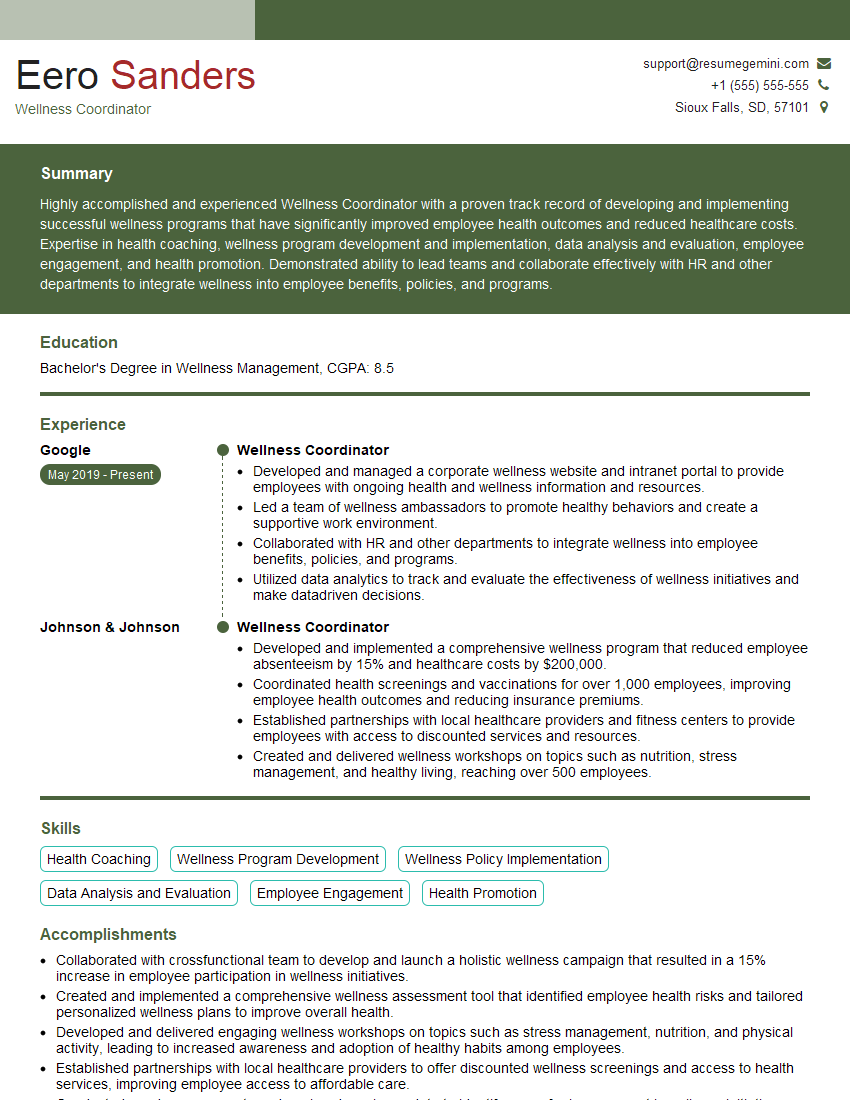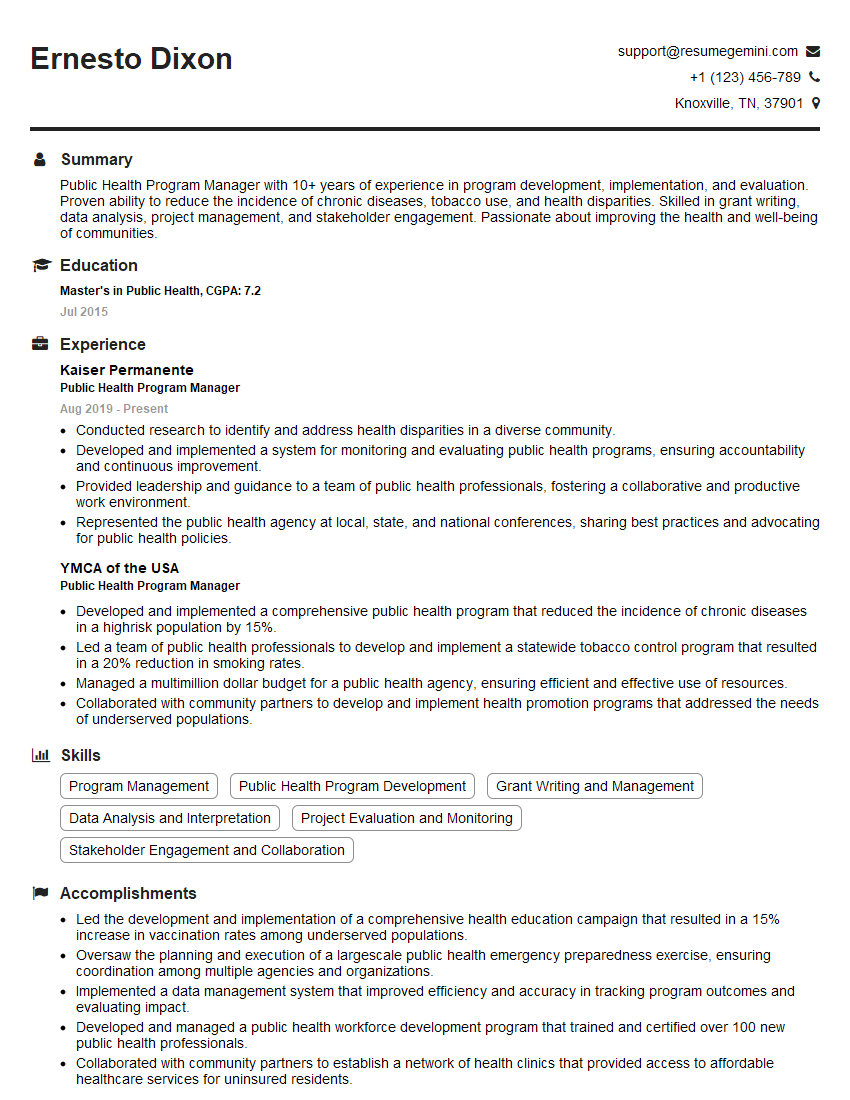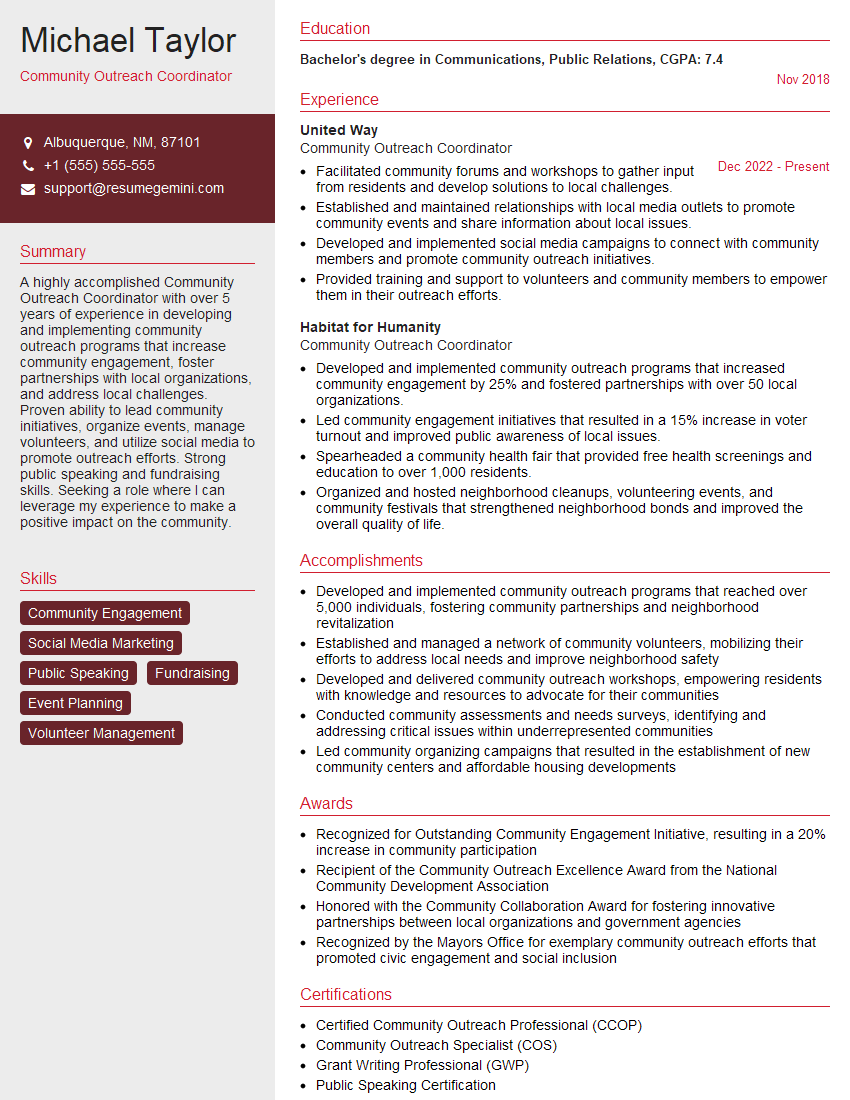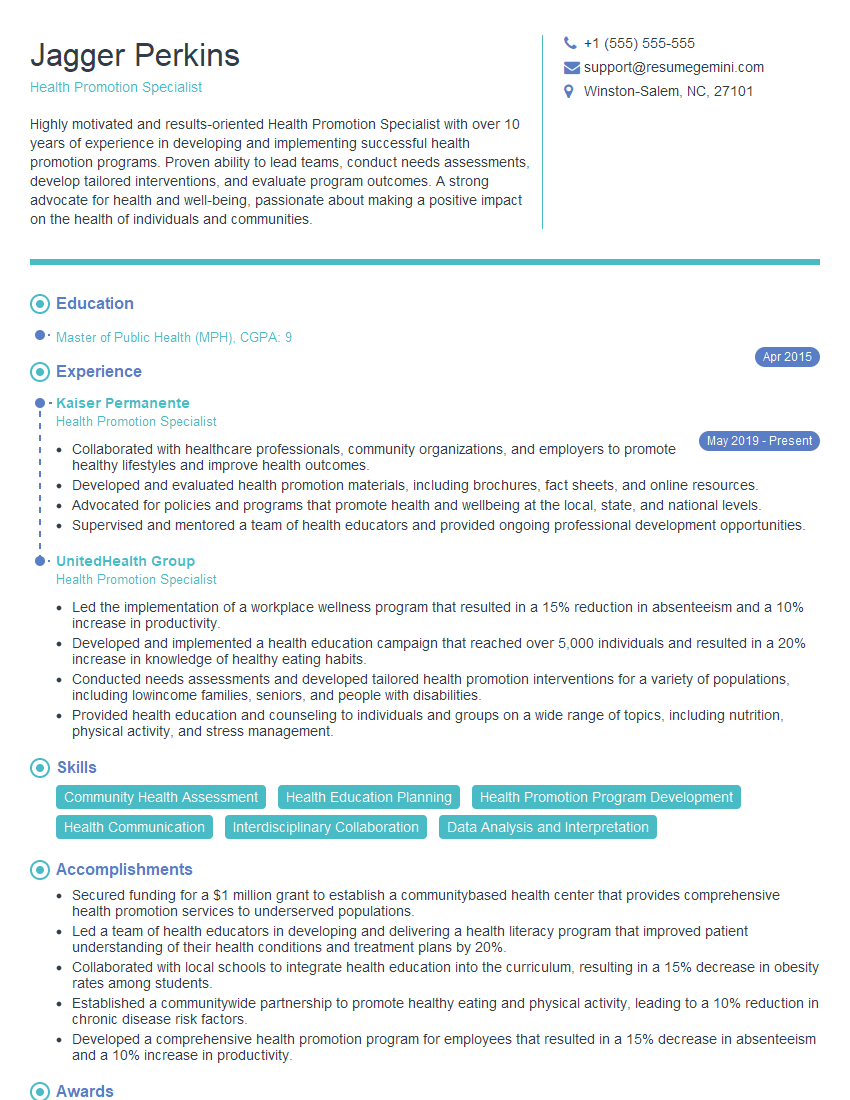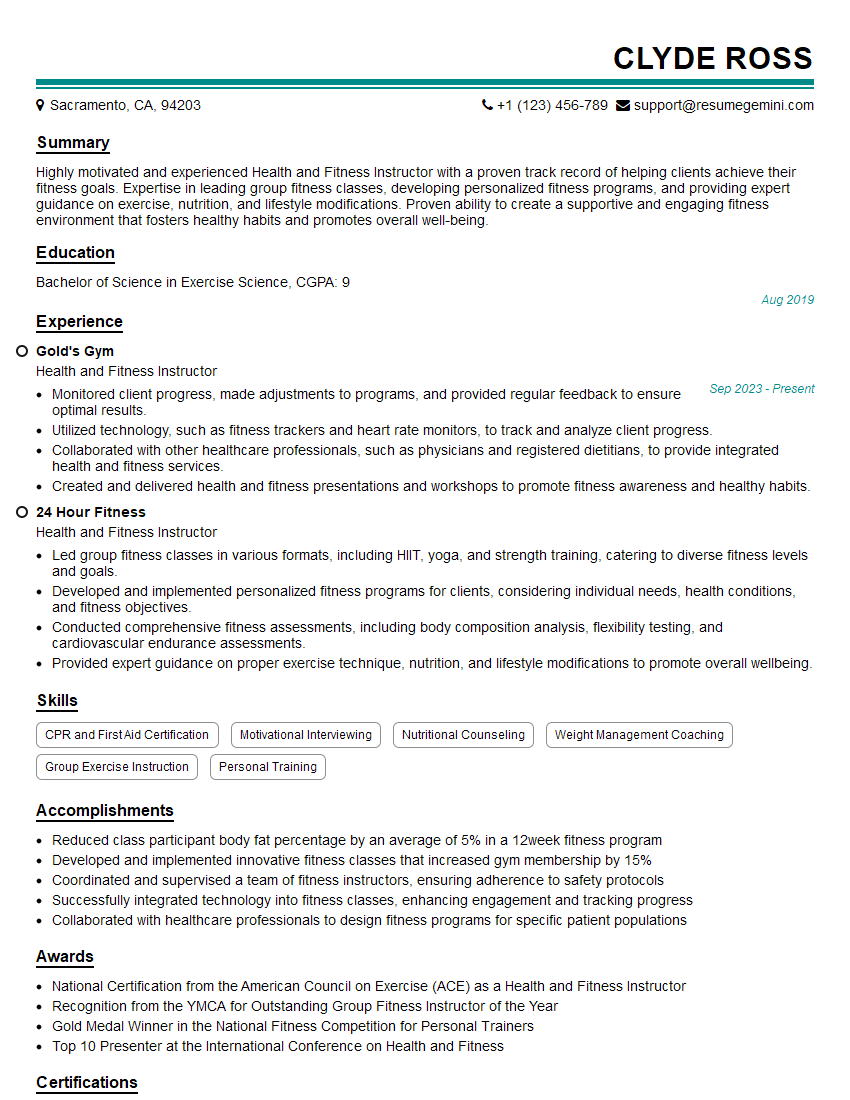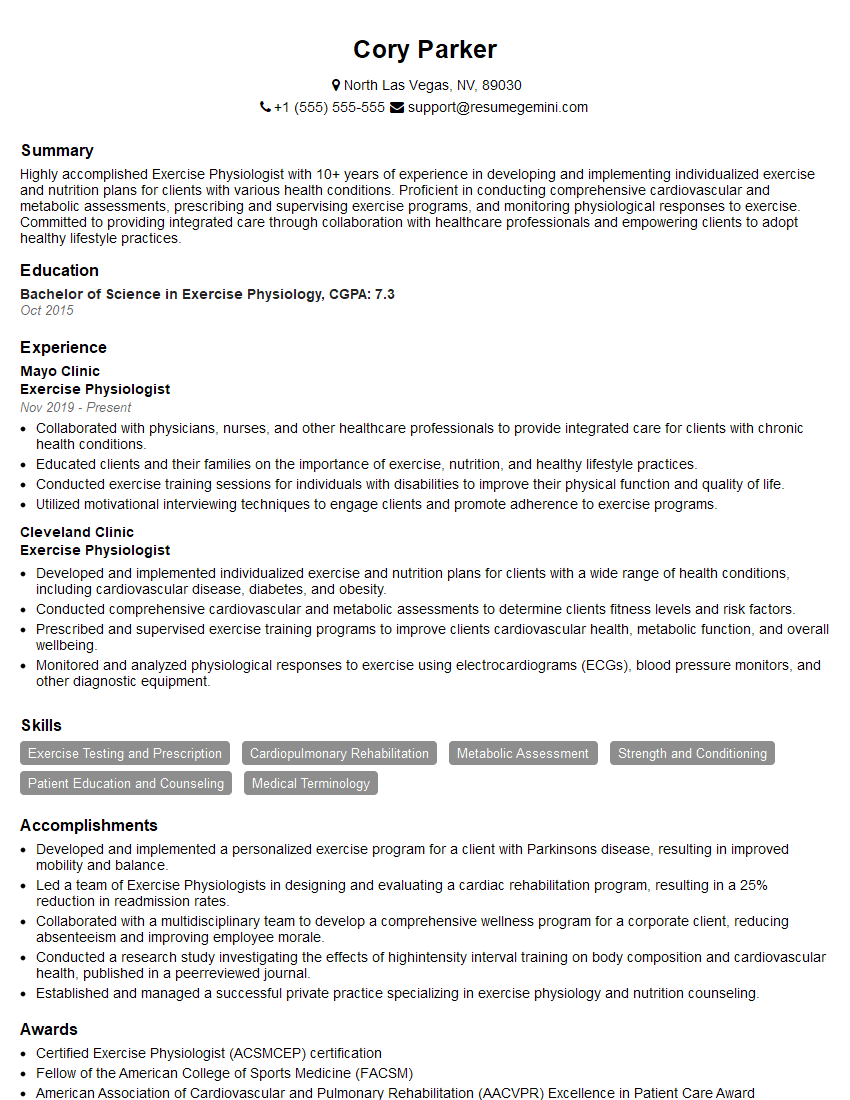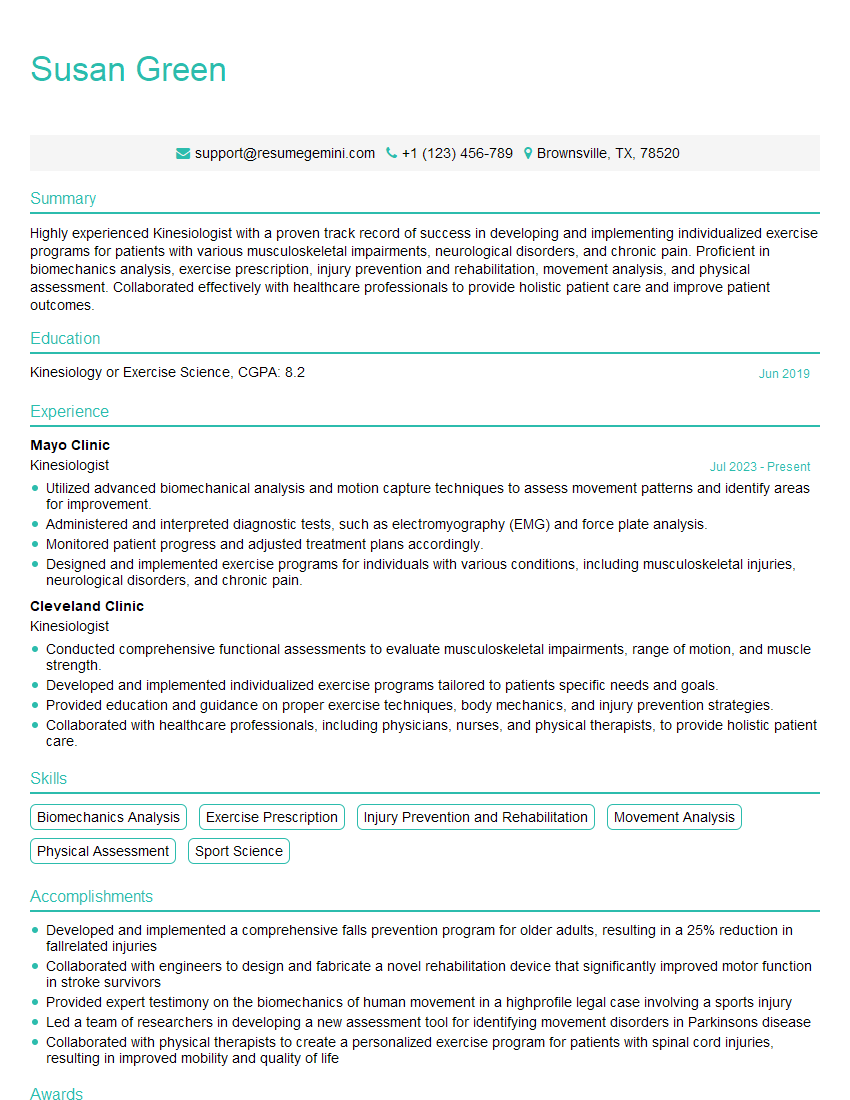Unlock your full potential by mastering the most common Advocacy for Physical Activity interview questions. This blog offers a deep dive into the critical topics, ensuring you’re not only prepared to answer but to excel. With these insights, you’ll approach your interview with clarity and confidence.
Questions Asked in Advocacy for Physical Activity Interview
Q 1. Describe your experience developing and implementing physical activity programs.
My experience in developing and implementing physical activity programs spans over a decade, encompassing various settings from community-based initiatives to large-scale public health campaigns. I’ve been involved in every stage, from needs assessment and program design to implementation, evaluation, and dissemination of findings. For example, in one project, we designed a school-based program promoting daily physical activity through active commuting, incorporating games during recess, and integrating movement into classroom learning. This involved collaboration with teachers, parents, and school administrators. Another project focused on creating accessible exercise programs for older adults in low-income neighborhoods, which included addressing transportation barriers and providing culturally relevant activities.
- Needs Assessment: Identifying community needs and gaps in existing services through surveys, focus groups, and data analysis.
- Program Design: Developing evidence-based interventions tailored to the specific needs and context of the target population.
- Implementation: Successfully deploying programs through training, community outreach, and resource mobilization.
- Evaluation: Measuring program effectiveness using quantitative and qualitative methods, such as tracking participation rates and assessing changes in physical activity levels.
- Dissemination: Sharing findings through publications, presentations, and community reports to improve future programs.
Q 2. How would you assess the physical activity levels of a community?
Assessing a community’s physical activity levels requires a multi-pronged approach combining objective and subjective measures. We can’t rely on just one method. Think of it like getting a complete health picture—you need various tests, not just one.
- Objective Measures: These provide quantifiable data. We might use accelerometers to measure movement throughout the day, or analyze data from community surveys to see the prevalence of walking, cycling or other physical activities.
- Subjective Measures: These involve self-reported data. This includes questionnaires and interviews to assess physical activity habits, barriers, and motivations. For instance, we might ask about frequency, intensity, and duration of exercise, as well as participation in sports or recreational activities.
- Environmental Audits: We would also assess the built environment, such as the availability of parks, trails, and safe places to walk, bike, or play. The presence of obstacles like busy roads or lack of safe spaces can significantly impact physical activity levels.
By combining these methods, we get a comprehensive picture of the community’s physical activity landscape, allowing for targeted interventions.
Q 3. What strategies would you use to promote physical activity among diverse populations?
Promoting physical activity among diverse populations requires culturally sensitive and tailored strategies. A one-size-fits-all approach won’t work. Imagine trying to fit everyone into the same pair of shoes – it just won’t be comfortable.
- Culturally Relevant Programming: Activities should align with the cultural preferences, values, and beliefs of the specific community. This might involve offering dance classes, traditional sports, or other activities relevant to the culture.
- Community Partnerships: Engaging community leaders, faith-based organizations, and local businesses builds trust and increases reach. This way the community feels heard and supported.
- Language Accessibility: Materials and programs should be available in multiple languages to overcome language barriers.
- Addressing Social Barriers: Understanding and tackling barriers like access to safe spaces, transportation, cost, and childcare is essential. Consider offering subsidized programs or transportation assistance.
- Inclusive Marketing & Communication: Use diverse imagery and messaging to make the program appealing to all populations. It should be seen as a positive, inclusive experience rather than one directed at a specific group.
Q 4. Explain your understanding of the social determinants of health and their impact on physical activity.
Social determinants of health (SDOH) are the conditions in the environments where people are born, live, learn, work, play, worship, and age that affect a wide range of health, functioning, and quality-of-life outcomes and risks. These factors significantly influence physical activity levels. For example, someone living in a neighborhood lacking safe parks or sidewalks is far less likely to be physically active compared to someone who lives near accessible recreational facilities.
- Economic Stability: Income, employment, and food security significantly impact a person’s ability to afford gym memberships, sports equipment, or healthy food options.
- Education Access: Higher education levels are often associated with greater health literacy and awareness of the benefits of physical activity.
- Social and Community Context: Social support networks and community engagement play a vital role in motivation and adherence to physical activity programs. Strong social support can act as a powerful motivator.
- Health Care Access: Regular access to healthcare facilitates early identification of health issues that might impact physical activity and promotes personalized guidance.
- Neighborhood and Built Environment: The availability of safe spaces for physical activity, such as parks, trails, and recreational facilities, is crucial. The presence of safe walking and cycling routes also plays a big part.
Understanding these SDOH allows us to develop more effective interventions addressing the root causes of inactivity, rather than simply focusing on individual behavior change.
Q 5. How would you overcome barriers to physical activity participation?
Overcoming barriers to physical activity participation requires a comprehensive approach tailored to the specific obstacles identified within a community. Simply put, you have to understand the problem before you solve it.
- Addressing Lack of Time: Offering short, high-intensity workouts or incorporating activity into daily routines (e.g., taking the stairs) can be effective.
- Tackling Inaccessibility: Promoting transportation options, creating accessible facilities, and offering programs in convenient locations can increase participation.
- Managing Costs: Offering subsidized programs, promoting free community activities, or partnering with local organizations to provide affordable options can help.
- Overcoming Safety Concerns: Improving lighting in parks, increasing police presence, or offering group exercise classes in safer locations are necessary steps.
- Improving Health Literacy: Educating people about the benefits of physical activity and providing personalized guidance can increase motivation.
- Building Social Support: Promoting group activities, encouraging family participation, or establishing buddy systems enhances motivation and adherence.
Q 6. What are some evidence-based interventions for increasing physical activity?
Evidence-based interventions for increasing physical activity are grounded in behavioral science and public health research. They move beyond simply telling people to exercise.
- Community-Based Interventions: These include creating accessible recreational facilities, improving the built environment, and promoting community-wide events.
- School-Based Interventions: Integrating physical activity into the curriculum, providing physical education classes, and promoting active commuting to school.
- Workplace Interventions: Encouraging active commuting, establishing employee fitness programs, and promoting regular breaks for physical activity.
- Health Promotion Campaigns: Utilizing targeted marketing strategies to increase awareness of the benefits of physical activity and provide motivational messaging. These could utilize social media, public service announcements and local partnerships.
- Technology-Based Interventions: Using mobile apps, wearable devices, and online platforms to track progress, provide feedback, and promote engagement. Gamification is also frequently used here.
- Social Support Interventions: Establishing group exercise programs, promoting buddy systems, and fostering social networks among individuals working towards similar goals.
It’s important to note that the most effective interventions are often multi-component approaches combining several strategies. For example, a successful school-based program might incorporate curriculum changes, community outreach, and technology-based support.
Q 7. Describe your experience working with stakeholders to promote physical activity.
Successful physical activity promotion requires collaboration with diverse stakeholders. Think of it as an orchestra; each section plays a vital role, and they need to work in harmony to create beautiful music.
- Community Leaders: Building relationships with community leaders (mayors, council members, etc.) secures buy-in and resources.
- Healthcare Professionals: Integrating physical activity recommendations into healthcare settings ensures comprehensive support for individuals.
- Schools and Educators: Engaging schools and teachers promotes consistent physical activity among children and youth.
- Businesses and Employers: Workplace wellness programs can encourage physical activity among employees.
- Community Organizations: Partnering with local organizations extends program reach and builds community support.
- Policy Makers: Advocacy for policies that support physical activity (e.g., creating bike lanes, investing in parks) is crucial for long-term sustainability.
Effective stakeholder engagement involves clear communication, mutual respect, and shared goals. Regular meetings, feedback mechanisms, and collaborative decision-making are essential for success.
Q 8. How would you measure the effectiveness of a physical activity program?
Measuring the effectiveness of a physical activity program requires a multi-faceted approach, going beyond simply counting participants. We need to assess changes in both behavior and health outcomes.
Behavioral Measures: These track changes in physical activity levels. We might use self-reported questionnaires (like the International Physical Activity Questionnaire), wearable fitness trackers (Fitbit, Apple Watch), or accelerometers for objective data on steps, intensity, and duration. We also assess program participation rates – how many people enrolled, attended sessions, and maintained engagement over time.
Health Outcome Measures: These assess improvements in physical and mental well-being. This could include changes in body mass index (BMI), blood pressure, cholesterol levels, cardiovascular fitness (VO2 max), and even self-reported measures of mood and stress.
Example: In a workplace wellness program, we might measure changes in employee step counts (using fitness trackers), participation in offered exercise classes, and improvements in reported stress levels via pre- and post-program surveys. We’d also compare these results to a control group that didn’t participate in the program.
Ultimately, a robust evaluation combines quantitative data (numbers) with qualitative data (feedback from participants through interviews or focus groups) to gain a comprehensive understanding of the program’s impact.
Q 9. What are the key performance indicators (KPIs) you would track for a physical activity initiative?
Key Performance Indicators (KPIs) for a physical activity initiative should reflect both program reach and impact.
- Participation Rates: Number of individuals enrolled, attendance at sessions, and program completion rates.
- Physical Activity Levels: Changes in minutes of moderate-to-vigorous physical activity (MVPA) per week, measured objectively (accelerometers) or subjectively (questionnaires).
- Health Outcomes: Improvements in BMI, blood pressure, cholesterol, fitness levels (e.g., VO2 max), and self-reported health status.
- Social Impact: Increases in social connections through group activities, community engagement, and creation of supportive environments.
- Program Reach: Number of individuals reached through marketing and outreach efforts, diversity of participants, and geographic reach.
- Sustainability: Long-term program maintenance and continued participation after the initial intervention phase.
- Cost-Effectiveness: Evaluation of program costs compared to the achieved health outcomes, often expressed as cost per unit of change in a health outcome (e.g., cost per unit decrease in BMI).
Regular monitoring of these KPIs allows for ongoing program evaluation and adjustment to maximize effectiveness.
Q 10. How would you adapt a physical activity program to meet the needs of individuals with disabilities?
Adapting physical activity programs for individuals with disabilities requires careful consideration of individual needs and limitations. It’s crucial to embrace the principle of inclusion rather than segregation.
Assessment: Begin by conducting thorough assessments to understand each individual’s abilities, limitations, and preferences. This might involve consultations with healthcare professionals (physiotherapists, occupational therapists) and the individual themselves.
Program Modification: Adapt the program by:
- Modifying intensity and duration: Offer shorter sessions or lower-intensity activities, allowing for frequent rest breaks.
- Adapting exercise types: Choose exercises suitable for different physical abilities, including seated, standing, or wheelchair-accessible options. Examples include adapted yoga, chair exercises, swimming, or water aerobics.
- Providing assistive devices: Ensure access to necessary equipment, such as walkers, wheelchairs, adaptive exercise equipment, or other assistive technology.
- Creating inclusive environments: Adapt facilities and spaces to ensure accessibility for all participants, complying with accessibility guidelines.
- Offering personalized support: Provide individual instruction and support from trained professionals who understand the specific needs of people with disabilities.
Example: In an adapted group fitness class, a qualified instructor might offer modifications to exercises, provide verbal cues and encouragement, and ensure the environment is safe and inclusive for participants with diverse mobility levels.
Remember, always consult with healthcare professionals and prioritize the individual’s safety and well-being.
Q 11. What is your experience in grant writing or securing funding for physical activity projects?
I have extensive experience in grant writing and securing funding for physical activity projects. My successes stem from a deep understanding of funding priorities and a data-driven approach to proposal development.
Experience: I have successfully secured funding from various sources including government agencies (e.g., the National Institutes of Health, local health departments), private foundations, and corporate sponsors. My proposals have focused on a range of initiatives, from community-based physical activity programs to research studies exploring the effectiveness of interventions.
Strategies: My grant writing process focuses on clearly articulating the project’s goals, methods, expected outcomes, and budget justification. I emphasize the project’s relevance to the funder’s priorities and demonstrate a strong understanding of the target population. The inclusion of robust evaluation plans is crucial, demonstrating how the impact of the initiative will be assessed.
Example: In a recent successful grant application, I demonstrated the cost-effectiveness of a school-based physical activity program by projecting reduced healthcare costs associated with improved student health outcomes. This strong evidence-based approach significantly strengthened the application.
Q 12. How familiar are you with health behavior theories and models (e.g., Transtheoretical Model, Social Cognitive Theory)?
I am very familiar with several health behavior theories and models, including the Transtheoretical Model (Stages of Change) and Social Cognitive Theory (SCT). These frameworks are essential tools in designing and implementing effective physical activity interventions.
Transtheoretical Model (Stages of Change): This model highlights the different stages individuals go through when changing a behavior (precontemplation, contemplation, preparation, action, maintenance). Tailoring interventions to match an individual’s stage of readiness increases their likelihood of success. For example, interventions for people in the precontemplation stage might focus on increasing awareness of the benefits of physical activity, while interventions for those in the action stage might focus on maintaining their progress.
Social Cognitive Theory (SCT): This theory emphasizes the interplay between personal factors, behavioral factors, and environmental factors in influencing behavior change. Interventions based on SCT often involve self-efficacy building (belief in one’s ability to succeed), observational learning (modeling positive behaviors), and environmental restructuring (creating supportive environments).
Practical Application: I use these models to develop targeted interventions. For instance, a program for individuals aiming to increase walking might incorporate strategies like goal setting (SCT), providing personalized feedback (SCT), and offering group support (SCT) while also considering the individual’s stage of readiness (Transtheoretical Model).
Q 13. Describe your experience using data and analytics to inform physical activity programming.
Data and analytics are crucial for informing effective physical activity programming. I utilize data in several ways:
- Needs Assessment: I use data from surveys, health records, and community health profiles to understand the needs and preferences of the target population. This helps to tailor programs to local contexts.
- Program Evaluation: I employ quantitative and qualitative data collection methods (questionnaires, wearable sensors, interviews) to assess program effectiveness, identify areas for improvement, and demonstrate impact to stakeholders.
- Targeting Interventions: I use data to identify specific populations who are most likely to benefit from interventions and to target resources effectively.
- Predictive Modeling: In some cases, I utilize predictive modeling techniques to identify factors associated with increased or decreased physical activity participation and design interventions to address these factors.
Example: In a community-based program, we used data from fitness trackers to assess changes in activity levels, correlated those changes with self-reported health improvements, and used these findings to refine the program’s delivery methods and content for greater success in subsequent implementations.
Q 14. How would you develop a marketing campaign to promote a physical activity program?
Developing a successful marketing campaign for a physical activity program requires a multi-channel approach tailored to the target audience.
Understanding the Audience: Begin with thorough market research to identify the needs, preferences, and media consumption habits of your target population. Consider factors such as age, demographics, socioeconomic status, and existing levels of physical activity.
Message Development: Craft compelling messages that highlight the benefits of participation and address potential barriers. Use positive and motivational language focusing on the enjoyable aspects of physical activity rather than solely on health risks.
Channel Selection: Use a combination of channels to reach the target audience, including:
- Social Media Marketing: Utilize platforms like Facebook, Instagram, and Twitter to engage with potential participants, share success stories, and run targeted advertising campaigns.
- Community Outreach: Partner with local organizations, community centers, and healthcare providers to promote the program.
- Traditional Media: Consider using local newspapers, radio, and television to reach a broader audience.
- Website and Email Marketing: Create a user-friendly website with information about the program, registration details, and success stories. Use email marketing to announce events and provide updates.
Evaluation: Regularly monitor the effectiveness of the campaign by tracking website traffic, social media engagement, registration numbers, and participant feedback. Use this information to refine the campaign and optimize its impact.
Q 15. What are the ethical considerations involved in promoting physical activity?
Ethical considerations in promoting physical activity are paramount. We must ensure equity, inclusivity, and respect for autonomy. For example, campaigns shouldn’t shame individuals for inactivity or promote unrealistic ideals of fitness. Instead, they should empower individuals to make informed choices based on their capabilities and circumstances. We need to consider accessibility – are our programs accessible to people with disabilities, diverse socioeconomic backgrounds, or limited transportation options? Another critical aspect is informed consent; participants must fully understand the risks and benefits before engaging in any physical activity program. Finally, we need to be mindful of cultural sensitivity and avoid promoting activities that might clash with cultural norms or beliefs. Ethical promotion means recognizing that physical activity is a personal journey and respecting individual choices.
Career Expert Tips:
- Ace those interviews! Prepare effectively by reviewing the Top 50 Most Common Interview Questions on ResumeGemini.
- Navigate your job search with confidence! Explore a wide range of Career Tips on ResumeGemini. Learn about common challenges and recommendations to overcome them.
- Craft the perfect resume! Master the Art of Resume Writing with ResumeGemini’s guide. Showcase your unique qualifications and achievements effectively.
- Don’t miss out on holiday savings! Build your dream resume with ResumeGemini’s ATS optimized templates.
Q 16. How would you address misinformation or misconceptions about physical activity?
Addressing misinformation is crucial. We utilize evidence-based strategies, primarily relying on clear and concise communication. For instance, instead of saying ‘exercise burns calories,’ we might explain how physical activity boosts metabolism, improves cardiovascular health, and contributes to overall well-being. This approach focuses on positive outcomes rather than solely emphasizing weight loss, which is often a misleading motivator. We leverage trusted sources like the CDC and WHO guidelines to debunk myths. Furthermore, we actively engage with communities through workshops, interactive sessions, and social media, directly addressing misconceptions and providing accurate information. For example, if someone believes that only intense exercise is beneficial, we explain the value of moderate-intensity activity and its cumulative effects. A multi-pronged approach combining education, engagement, and collaboration with credible sources is essential.
Q 17. How would you build community partnerships to support physical activity initiatives?
Building strong community partnerships is the cornerstone of successful physical activity initiatives. This involves collaboration with local organizations, schools, businesses, and healthcare providers. For example, we might partner with schools to implement physical education programs and after-school activities, with local businesses to sponsor community events, and with healthcare providers to integrate physical activity recommendations into patient care. We actively seek input from the community to ensure programs are relevant and meet their needs. This could involve community forums, surveys, or focus groups to understand barriers and preferences. Open communication and shared decision-making are key to forming long-lasting and productive partnerships. A strong partnership allows us to leverage resources, expand reach, and increase sustainability of the initiative.
Q 18. Describe your experience collaborating with healthcare providers to promote physical activity.
I have extensive experience collaborating with healthcare providers to promote physical activity. This often involves integrating physical activity recommendations into patient care plans. For example, I worked with a team of physicians and nurses to develop a program for cardiac rehabilitation patients, focusing on gradually increasing physical activity levels under medical supervision. We also collaborated on creating educational materials for patients and healthcare providers, incorporating evidence-based strategies for promoting physical activity. These collaborations often involved training healthcare providers on motivational interviewing techniques to better engage patients and support their adherence to exercise regimens. Successful collaborations require clear communication, shared goals, and a mutual understanding of the roles each party plays. My experience highlights the importance of working within the existing healthcare system to optimize the promotion of physical activity.
Q 19. How do you stay up-to-date on the latest research and best practices in physical activity?
Staying current involves a multi-faceted approach. I regularly review peer-reviewed journals like the Medicine & Science in Sports & Exercise and British Journal of Sports Medicine. I attend professional conferences and workshops to learn about the latest research findings and best practices. I also actively participate in professional organizations like the American College of Sports Medicine (ACSM), which provides access to resources, publications, and continuing education opportunities. Additionally, I regularly monitor government health agencies like the CDC and WHO websites for updates on guidelines and recommendations. This holistic approach ensures I’m constantly updating my knowledge and applying the most effective strategies in my work.
Q 20. How would you evaluate the feasibility of a proposed physical activity intervention?
Evaluating the feasibility of a physical activity intervention involves a structured process. Firstly, we assess the need – is there a genuine demand for this intervention? Then we analyze the resources – do we have the funding, personnel, and facilities needed? Next, we evaluate the context – are there community factors that may influence success or failure? For example, a program requiring access to transportation might not be feasible in a rural area. We also assess the acceptability – would the target population be interested in this intervention? This often involves pilot testing and gathering feedback. Finally, we consider sustainability – can the program be maintained long-term without external funding? A thorough feasibility assessment, using a structured framework and data-driven decision-making, increases the likelihood of a successful and sustainable intervention.
Q 21. What are the potential risks and benefits of different physical activity interventions?
Different interventions have varying risks and benefits. For example, high-intensity interval training (HIIT) offers rapid improvements in fitness but carries a higher risk of injury, especially for beginners. Conversely, moderate-intensity continuous training (MICT) is safer but might require a longer duration to achieve similar fitness improvements. Walking is generally low-risk and accessible to most, but the fitness gains might be slower compared to more vigorous activities. We must consider individual factors like age, health status, and physical limitations when choosing interventions. A comprehensive risk assessment, along with careful planning and supervision, can mitigate potential risks. The benefits, ranging from improved cardiovascular health and mental well-being to reduced chronic disease risk, should always outweigh the risks with proper planning and consideration for individual needs.
Q 22. How would you handle resistance or opposition to physical activity initiatives?
Resistance to physical activity initiatives often stems from misconceptions, lack of access, or perceived inconvenience. My approach involves understanding the root cause of this resistance through community engagement and needs assessments.
- Addressing Misconceptions: I utilize evidence-based information and positive messaging to counter myths about exercise being too strenuous or requiring excessive time. For example, I might highlight the benefits of short bursts of activity throughout the day, or emphasize the importance of finding activities that are enjoyable.
- Improving Access: I advocate for policies and programs that increase access to safe and affordable physical activity opportunities, including parks, recreational facilities, and transportation options. This may involve collaborating with local governments and community organizations to create inclusive spaces.
- Making it Convenient: I work to integrate physical activity into daily routines through workplace wellness programs, school-based initiatives, and community-based activities that are easily accessible and convenient. This might include promoting active commuting, creating walking trails near residential areas, or offering lunchtime exercise programs.
- Tailoring the Message: I ensure the messaging resonates with the specific target audience by utilizing diverse communication channels and culturally sensitive approaches. This might mean translating materials into multiple languages or engaging community leaders to promote physical activity within their own networks.
Q 23. Describe your experience using technology (e.g., apps, wearables) to support physical activity.
Technology plays a crucial role in supporting physical activity. I’ve extensively used various apps and wearables to monitor progress, provide motivation, and personalize exercise routines.
- Fitness Tracking Apps: I’ve worked with clients using apps like MyFitnessPal, Strava, and Fitbit to track steps, calories burned, and exercise duration. This data provides valuable insights into activity levels and helps individuals set realistic goals.
- Wearable Technology: I’ve utilized smartwatches and fitness trackers to monitor heart rate, sleep patterns, and activity levels. The real-time feedback these devices provide can be highly motivating, and the data collected can be used to adjust training plans and personalize interventions.
- Gamification: Many apps incorporate game-like elements to enhance engagement. I’ve found that incorporating challenges, rewards, and social features significantly improves adherence to physical activity programs.
- Remote Coaching and Monitoring: Technology enables remote coaching and monitoring, allowing me to support individuals even if they are not physically present. This is particularly valuable for individuals with limited access to in-person support.
For example, I’ve successfully implemented a program using a fitness tracking app combined with weekly online check-ins to provide personalized feedback and support, resulting in significant improvements in client adherence and overall fitness levels.
Q 24. How would you tailor a physical activity message to different age groups?
Tailoring physical activity messages to different age groups is crucial for effective advocacy. The approach must consider the developmental stage, interests, and capabilities of each group.
- Children (Preschool – Elementary): Focus on fun and play-based activities. Emphasize the importance of active play and limiting screen time. Use age-appropriate language and imagery.
- Adolescents (Middle School – High School): Highlight social aspects of physical activity. Promote team sports, group fitness classes, and activities that foster peer interaction. Address body image concerns and the importance of physical and mental health.
- Adults (Young Adults – Middle Age): Emphasize the benefits of physical activity for stress reduction, improved mood, and disease prevention. Offer convenient and accessible options like lunchtime workouts or home-based exercise programs.
- Older Adults (65+): Focus on maintaining functional fitness and preventing age-related decline. Promote low-impact activities like walking, swimming, and yoga. Address safety concerns and potential health limitations.
For instance, when designing a campaign for adolescents, incorporating influencers or celebrities they admire could increase engagement. For older adults, highlighting the social aspect of group exercise and emphasizing the low-impact nature of the activity is critical.
Q 25. How would you create a sustainable physical activity program?
Creating a sustainable physical activity program requires a multi-faceted approach focusing on long-term engagement and community involvement.
- Community Engagement: Collaborate with local stakeholders to identify community needs and preferences for physical activity programs. This includes involving community leaders, schools, businesses, and recreational facilities.
- Accessibility and Affordability: Make programs readily accessible, convenient, and affordable for all members of the community. Consider offering free or subsidized programs in underserved areas.
- Variety and Choice: Offer a diverse range of activities to cater to different interests, abilities, and preferences. This could include dance, yoga, team sports, individual fitness, or walking groups.
- Social Support: Incorporate social components into programs to foster a sense of community and encourage mutual support. This might include group fitness classes, walking clubs, or team-based activities.
- Monitoring and Evaluation: Regularly assess the program’s effectiveness through data collection and feedback mechanisms. This ensures the program adapts to meet the evolving needs of the community.
- Sustainability Plan: Develop a comprehensive sustainability plan that outlines strategies for long-term funding, leadership, and program maintenance. This might involve securing grants, developing partnerships with community organizations, or building a robust volunteer base.
For instance, a sustainable program might involve partnering with a local park district to offer free fitness classes, incorporating local businesses as sponsors, and establishing a volunteer system to assist with program delivery and maintenance. A strong community advisory board can help ensure the program’s ongoing relevance and success.
Q 26. What is your experience with policy advocacy related to physical activity?
My policy advocacy experience includes working with local and state governments to promote policies that support physical activity.
- Advocating for Increased Funding: I’ve worked to secure funding for parks, recreation facilities, and community-based physical activity programs. This often involves building coalitions with other organizations and presenting data demonstrating the economic and health benefits of physical activity.
- Promoting Active Transportation: I’ve advocated for policies that encourage walking and cycling, such as building bike lanes, improving pedestrian infrastructure, and implementing complete streets initiatives.
- Supporting Physical Activity in Schools: I’ve worked to advocate for policies that increase physical education in schools, reduce screen time, and promote active school environments.
- Health Insurance Coverage: I’ve supported policies that provide better health insurance coverage for preventative health services, including physical activity programs.
- Data Collection and Reporting: I’ve emphasized the importance of collecting reliable data on physical activity levels to inform policy decisions and track progress towards health goals.
For example, I worked with a local city council to pass a resolution increasing funding for community parks and creating new walking trails, resulting in increased opportunities for physical activity in an underserved community.
Q 27. How would you address health disparities related to physical activity?
Addressing health disparities related to physical activity requires a comprehensive approach focusing on equity and social justice.
- Identifying Barriers: Conduct thorough community needs assessments to identify the specific barriers to physical activity faced by different population groups, such as lack of access, safety concerns, cultural norms, or socioeconomic factors.
- Culturally Sensitive Interventions: Develop and implement culturally appropriate interventions that resonate with the specific values and beliefs of each community. This might involve working with community leaders and cultural organizations to create programs that are sensitive to the needs of diverse populations.
- Addressing Social Determinants of Health: Address the underlying social determinants of health that contribute to health disparities, such as poverty, lack of access to healthcare, and environmental injustices.
- Community-Based Participatory Research: Engage communities as partners in the research and implementation process to ensure programs are relevant, effective, and sustainable.
- Policy Changes: Advocate for policy changes that address systemic inequities and promote equitable access to opportunities for physical activity, such as providing subsidies for low-income families, developing safe and accessible parks in underserved areas, and integrating physical activity into healthcare settings.
For instance, a program aimed at improving physical activity in a low-income community might involve providing transportation assistance to local recreation centers, offering affordable fitness classes, and partnering with local food banks to promote healthy eating habits.
Q 28. Describe your experience working within a team to achieve physical activity goals.
Teamwork is essential in achieving physical activity goals. My experience includes collaborating with diverse teams to develop and implement successful initiatives.
- Shared Vision: Effective teamwork begins with establishing a clear shared vision and goals. This involves open communication, active listening, and collaborative decision-making.
- Diverse Expertise: I value the input of team members with diverse expertise, including public health professionals, community leaders, exercise specialists, educators, and policymakers. This ensures a comprehensive and multi-faceted approach.
- Effective Communication: Open and transparent communication is vital for success. This includes regular meetings, clear roles and responsibilities, and frequent updates.
- Conflict Resolution: Addressing conflicts proactively and effectively is crucial. This involves respectful dialogue, compromise, and a focus on shared goals.
- Celebrate Successes: Acknowledging and celebrating milestones and achievements helps maintain momentum and team morale.
For example, In one project, I worked with a team that included public health officials, community organizers, and fitness instructors to implement a successful community-based walking program. By leveraging the strengths of each member, we were able to overcome numerous challenges and achieve significant outcomes. We made sure everyone felt heard and valued, which significantly strengthened team cohesion and overall productivity.
Key Topics to Learn for Advocacy for Physical Activity Interview
- Understanding the Social Determinants of Health and Physical Activity: Explore how factors like socioeconomic status, access to resources, and cultural norms influence physical activity levels and devise strategies to address these barriers.
- Developing and Implementing Effective Health Promotion Campaigns: Learn about campaign design principles, target audience analysis, and evaluation methodologies. Consider practical applications such as creating social media campaigns or community-based initiatives to promote physical activity.
- Policy and Advocacy Strategies: Understand the role of policy in shaping physical activity environments. Explore how to advocate for changes in policies at local, regional, or national levels to increase access to and opportunities for physical activity. This includes understanding policy analysis and advocacy techniques.
- Community Engagement and Collaboration: Discuss strategies for building partnerships with community organizations, schools, and healthcare providers to promote physical activity. Practical experience in collaborative projects will be highly beneficial.
- Data Analysis and Program Evaluation: Learn how to collect, analyze, and interpret data related to physical activity interventions. Understanding program evaluation methods and their application is critical for demonstrating impact and securing further funding.
- Health Communication and Behavior Change Theories: Familiarize yourself with key theories and models (e.g., Social Cognitive Theory, Transtheoretical Model) and their practical application in designing interventions to increase physical activity.
- Ethical Considerations in Health Promotion: Understand ethical principles related to research and implementation of physical activity programs, including informed consent and cultural sensitivity.
Next Steps
Mastering Advocacy for Physical Activity opens doors to impactful careers, allowing you to make a tangible difference in public health. A strong resume is crucial for showcasing your skills and experience to potential employers. Creating an ATS-friendly resume maximizes your chances of getting noticed by Applicant Tracking Systems. We highly recommend using ResumeGemini to build a professional and effective resume that highlights your unique qualifications. ResumeGemini provides examples of resumes tailored to Advocacy for Physical Activity to guide you through the process, ensuring your application stands out.
Explore more articles
Users Rating of Our Blogs
Share Your Experience
We value your feedback! Please rate our content and share your thoughts (optional).
What Readers Say About Our Blog
Hi, I’m Jay, we have a few potential clients that are interested in your services, thought you might be a good fit. I’d love to talk about the details, when do you have time to talk?
Best,
Jay
Founder | CEO
